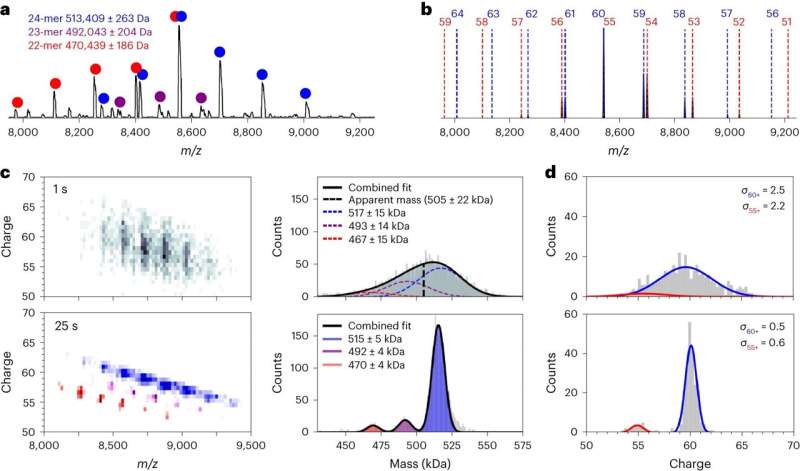This article has been reviewed according to Science X's editorial process and policies. Editors have highlighted the following attributes while ensuring the content's credibility:
fact-checked
trusted source
proofread
Chemists break barriers and open up super-resolution molecule mass analysis

A team of chemists led by Prof. Albert Heck puts a new spin on analyzing and understanding molecules. By ingeniously improving current measuring equipment, the team was able to trap and observe individual molecules for a much longer period—up to 25 seconds. This extended observation time enabled them to see the finer details of molecules, enhancing their understanding.
The precision upgrade is comparable to measuring a mass difference of one in a million. Heck compares it to a bag of sugar. "This precision relates to being able to tell that one sugar grain is missing from a full bag of 1 kilogram of sugar", says Heck.
The team published their results today in the journal Nature Methods. Their massive resolution upgrading could benefit the fabrication of vaccines and molecular vectors used in gene therapy.
A thousand times longer
Traditionally, chemists use a technology called mass spectrometry to examine the composition of molecules. Although this offers analyses in substantial levels of detail, its downside is that it looks at millions of molecules at once. This makes it tricky to study large molecules because the higher number of trapped molecules interfere with each other.
So, they developed a new method whereby just a single molecule is trapped in a so-called Orbitrap while heavily spinning. By measuring the spinning behavior, they are able to analyze the mass and composition of the molecule.
Normally, this method can only record signals for a short duration, typically around 25 milliseconds. In their study, the scientists modified the data acquisition method, allowing them to trap and monitor individual ions a thousand times longer, for up to an impressive 25 seconds.
To understand this advancement, imagine swinging on a swing for just a few seconds versus swinging for a prolonged period. The longer you swing, the more accurately an observer can measure your rhythm and deduce characteristics about you. Similarly, by trapping spinning ions for an extended duration, scientists can capture more detailed information about their spinning frequency and thus better characterize molecules.
Being able to measure giant molecules in such detail could pave the way for advancements in various fields, says Heck. One example is the production of therapeutic molecules, such as viruses, clinically used in gene therapy. These viruses are loaded with a human correctly functioning gene that replaces erroneous genes in the DNA of patients suffering from a genetic disorder.
Heck says, "Up until now, developers of gene therapy viruses cannot really verify if a virus harbors the specific gene that it is supposed to deliver. It is estimated that by current methods, only 1 to 2 percent of the produced gene therapy viruses are successfully loaded with the desired gene. This induces o that a substantial part of the therapeutic viruses introduced in a patient will have no effect."
If gene therapy developers can better measure the difference between 'empty' versus 'filled' viruses, they could make their production lines more efficient. Heck says, "When you consider that some of the gene therapy treatments cost around 1 million euros per treatment, this efficiency improvement could have a significant beneficial impact."
More information: Evolène Deslignière et al, Ultralong transients enhance sensitivity and resolution in Orbitrap-based single-ion mass spectrometry, Nature Methods (2024). DOI: 10.1038/s41592-024-02207-8
Provided by Utrecht University





















